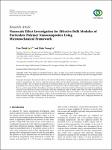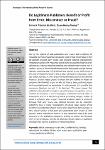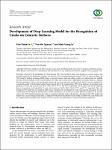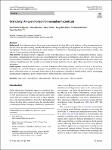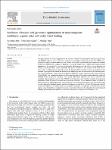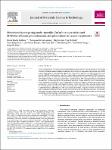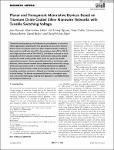Search
Author
- Anh-Tuan Le (12)
- Quan-Hoang Vuong (12)
- Ngo Xuan Dinh (8)
- Minh-Hoang Nguyen (7)
- next >
Subject
- Nanoparticles (4)
- Open Science (4)
- Compound droplet (3)
- Economics (3)
- next >
Has File(s)
Search Results
This paper investigates the nanoscale effect on the effective bulk modulus of nanoparticle-reinforced polymer. An interface-based model is introduced in this work to study the nanoscale effects on the effective properties of heterogeneous materials. That interface model is able to capture discontinuity of mechanical fields across the surface between the nanoparticle and matrix. A generalized self-consistent scheme is then employed to determine the effective bulk modulus. It has been seen from the results that, in a certain range of limits, the influence of nanoscale effects on effective properties of heterogeneous materials is significant and needs to be taken into account. In particular, when the nanoparticle radius is smaller than 10 nm, the value of effective bulk modulus signifi... |
One of the aspects of post-publication peer review that is difficult for reputable journals or publishers to accept is that it may reveal flaws in their oft-claimed resilient peer review and efficient editorial management. Prospective authors are frequently sold a brand-associated image of a fail-safe process, rigorous editorial handling, and stringent peer review. Yet, in reality, a sector of the published literature that has passed through claimed rigorous screening may still be flawed and contain errors, while some of the peer-reviewed literature is the product of fraud or misconduct. Even top-ranked journals, in terms of journal-based metrics such as the Clarivate Analytics’ journal impact factor, or those that are indexed or hosted on platforms like PubMed, Scopus or Web of Sci... |
This paper is devoted to the development of a deep learning- (DL-) based model to detect crack fractures on concrete surfaces. The developed model for the classification of images was based on a DL Convolutional Neural Network (CNN). To train and validate the CNN model, a database containing 40,000 images of concrete surfaces (with and without cracks) was collected from the available literature. Several conditions on the concrete surfaces were taken into account such as illumination and surface finish (i.e., exposed, plastering, and paint). Various error measurement criteria such as accuracy, precision, recall, specificity, and F1-score were employed for accessing the quality of the developed model. Results showed that for the training dataset (50% of the database), the precision, r... |
Venomous snake bite is common poisonous accident and important medical problem around the world. The snake anti-venom is only type-specific protection to each venom type that was used to immunize. In this study, the chicken egg yolk (IgY) antibodies against the Vietnamese cobra Naja Naja venom was developed and evaluated in in-vitro (ELISA and SDS-PAGE) and in-vivo (hen and mice immunization). In particularly, the LD50 of the Vietnamese cobra Naja Naja venom was determined at 1.46 g kg−1 body weight of the Swiss mice. The ISA Brown layers of 16 to 18-week-old were immunized intramuscularly with the Vietnamese cobra Naja Naja venom at 0.5 mg kg−1 body weight of the layers. The specific anti-venom antibodies were presented in both serum and egg yolk at 14 days, reached to highest anti... |
Background
Oral administration is the primary route employed for drug delivery. In addition to the gastrointestinal tract, the oral cavity has been drawing considerable attention owing to its physiological properties and advances in drug carrier development. Notably, nanotechnology has made immense contributions to enhancing drug bioavailability, stability, and efficacy, both in research and clinical settings.
Area covered
The present review comprises lessons from physiological characteristics to fundamental material science knowledge, summarizing the pros and cons of nanotechnology applications in therapeutic drug delivery. The oral cavity presents inherent challenges, including oral cancer, dental caries, oral infection, or oral inflammation, that necessitate local solutions.... |
This paper presents an analytical approach on the nonlinear vibration of nanocomposite multilayer organic solar cell (NMOSC) subjected to the combination of wind load and uniform temperature change. The NMOSC comprises of five layers, which are made of Al, P3HT:PCBM, PEDOT:PSS, Graphene and Glass. Compared to common models of the NMOSC, ITO is replaced by graphene to control the output colors of NMOSC. The nonlinear motion equations and the compatibility equation are deriving by taking into account the effect of viscous damping, von Karman nonlinearity terms, elastic foundations and initial imperfection. The formula of the wind load is improved for consideration in the general case that the direction of the wind load is not just perpendicular to the structure. Four edges of the NMOS... |
Chemo-resistance has pushed cancer treatment to the boundary of failure. This challenge has encouraged scientists to look for nanotechnological solutions. In this study, we have taken this goal one step further without depending on chemotherapy. Specifically, hybrid metal, polymer, and lipid nanoparticles that formed an IR780-a photosensitizer and Zinc copper oxide incorporated nanoparticle (ZCNP) nanoparticles were utilized in a combined photothermal and photodynamic therapy. Through the mediation of triphenylphosphonium (TPP) as a mitochondria-targeting moiety, TPP-conjugated polymer-lipid hybrid nanoparticles containing ZCNP/IR-780 significantly enhanced cellular uptake by cancer cells and selectively targeted the mitochondria, which improved the induction of apoptosis. In tumor-... |
We show that the canonical seesaw mechanism implemented by the
U
(
1
)
B
−
L
gauge symmetry provides two-component dark matter naturally. The seesaw scale that breaks
B
−
L
defines a residual gauge symmetry to be
Z
6
=
Z
2
⊗
Z
3
, where
Z
2
leads to the usual matter parity, while
Z
3
is newly recognized, transforming quark fields nontrivially. The dark matter components—that transform nontrivially under the matter parity and
Z
3
, respectively—can gain arbitrary masses, despite the fact that the
Z
3
dark matter may be heavier than the light quarks
u
,
d
. This dark matter setup can address the XENON1T anomaly recently observed and other observables, given that the dark matter masses are nearly degenerate, heavier than the electron a... |
Ethyl cellulose (EC) is widely used in the pharmaceutical field as a polymeric excipient to fabricate sustained-release drug delivery systems. To develop a controlled release carrier exploiting the unique characteristic acidic environment of the target tumor site, this study examined the use of EC and lecithin (LC) as a nanoparticulated system. Paclitaxel and dihydroartemisinin were used as model drug combinations. The optimized formulated nanoparticles (NPs) of EC (EC NPs) and EC/LC (EC/LC NPs) were spherical and approximately 130 nm in diameter as determined by dynamic light scattering and electron microscopy analyses. The in vitro drug release from EC/LC NPs exhibited a pH-dependent pattern. In in vitro cell studies, the NPs were taken up by cells, and cell growth was inhibited b... |
Threshold switching devices are fundamental active elements in more than Moore approaches, integrating the new generation of non-volatile memory devices. Here, the authors report an in-plane threshold resistive switching device with an on/off ratio above 106, a low resistance state of 10 to 100 kΩ and a high resistance state of 10 to 100 GΩ. Our devices are based on nanocomposites of silver nanowire networks and titanium oxide, where volatile unipolar threshold switching takes place across the gap left by partially spheroidized nanowires. Device reversibility depends on the titanium oxide thickness, while nanowire network density determines the threshold voltage, which can reach as low as 0.16 V. The switching mechanism is explained through percolation between metal–semiconductor is... |

